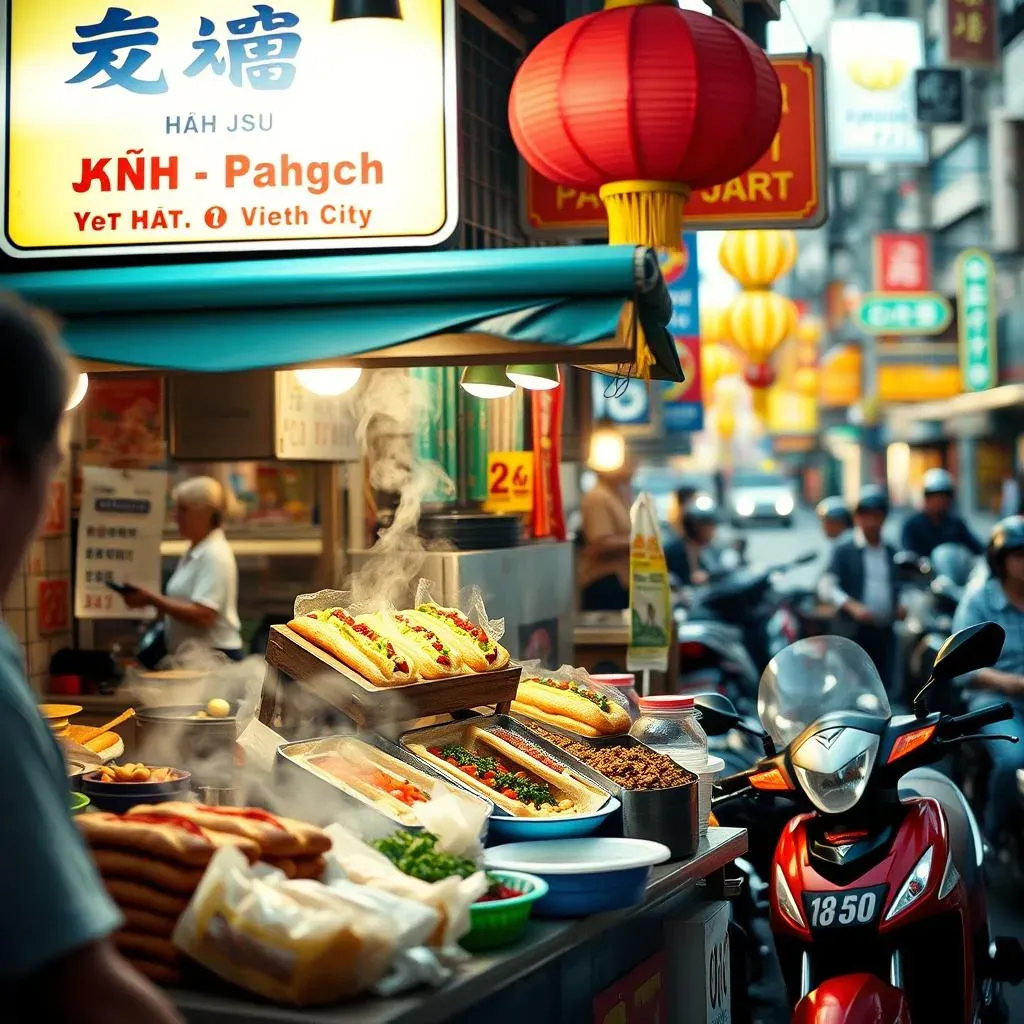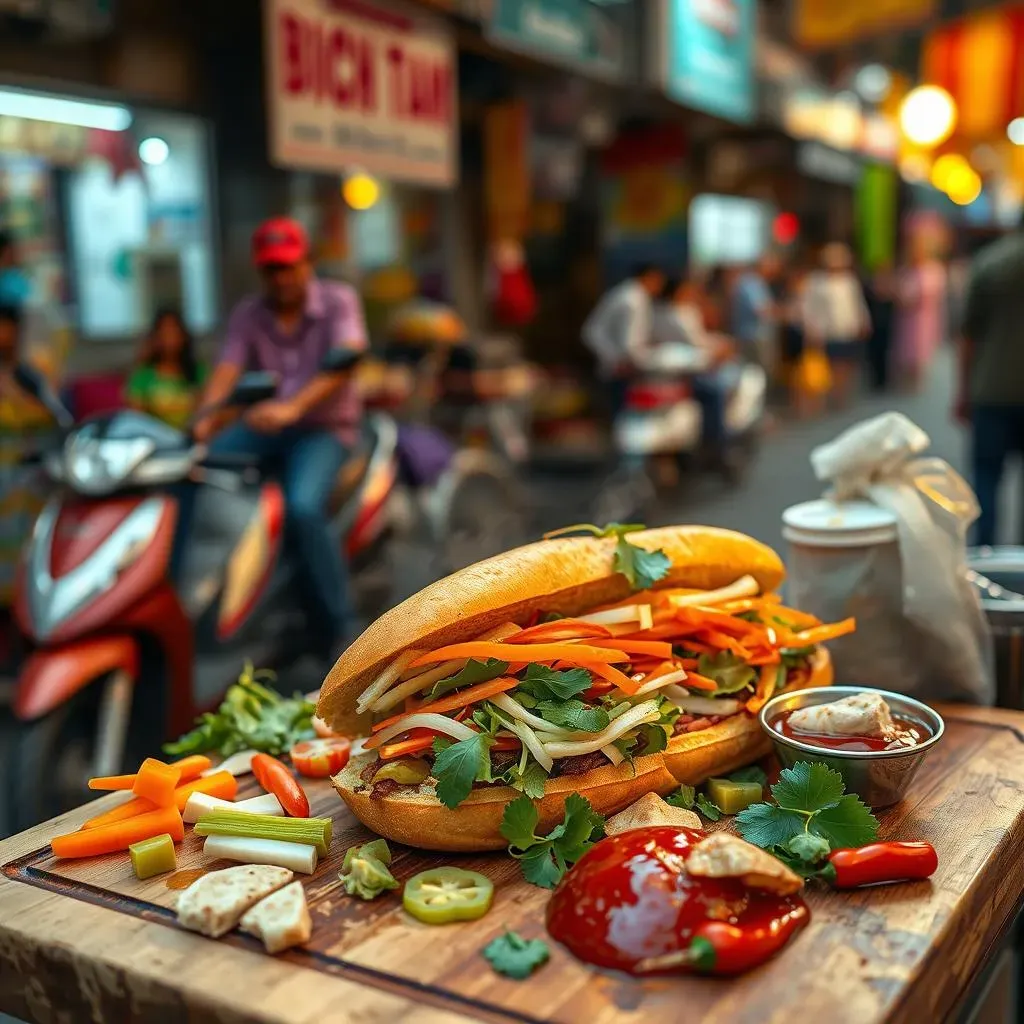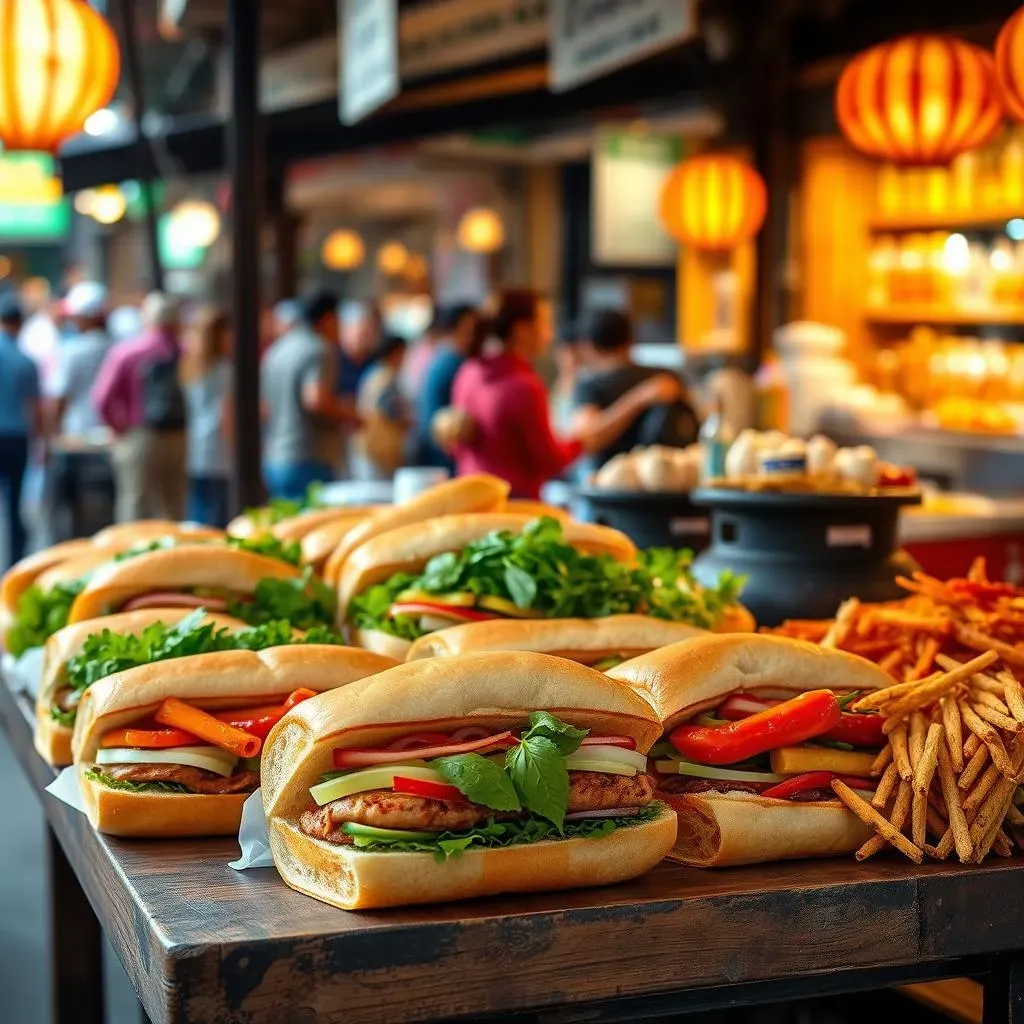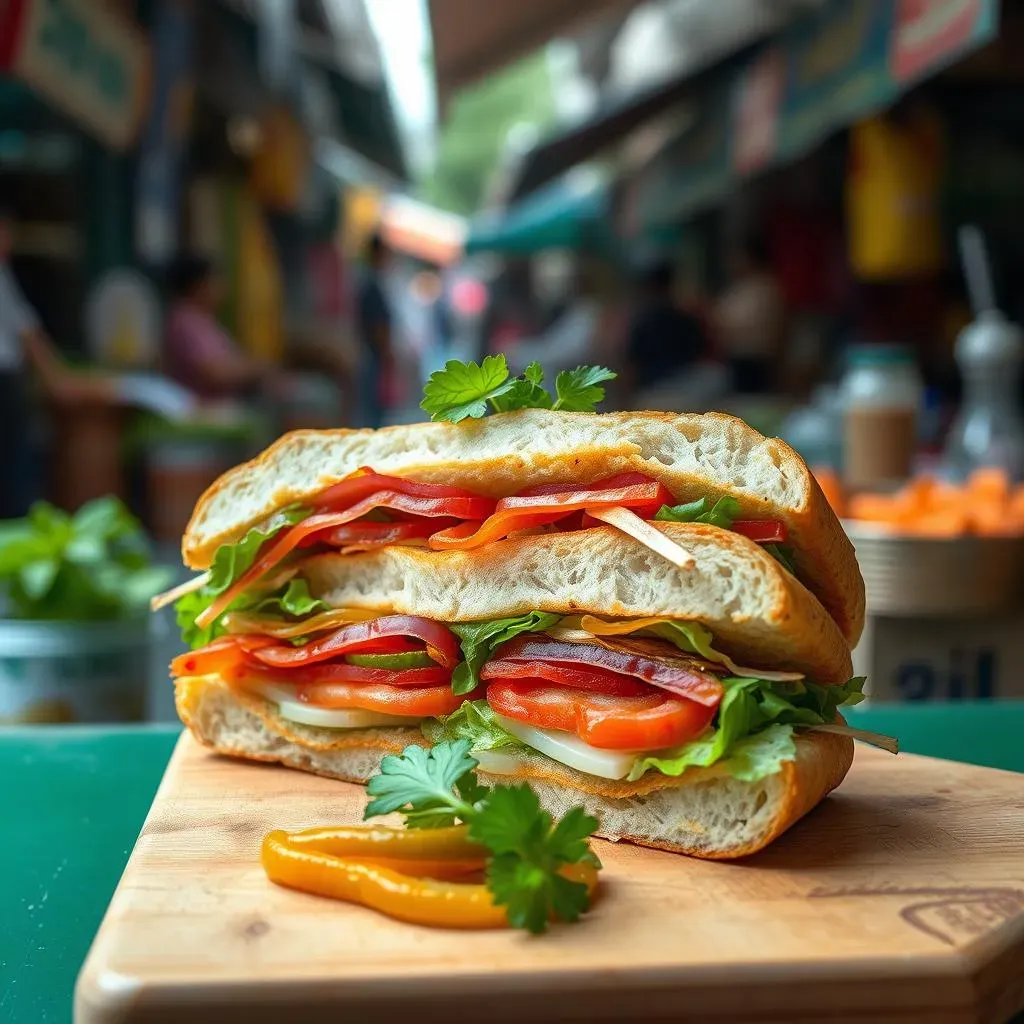Table of Contents
Embark on a flavorful adventure through the vibrant streets of Vietnam, where the iconic Vietnamese street food banh mi reigns supreme. This isn't just a sandwich; it's a culinary masterpiece, a symphony of textures and tastes that captures the essence of Vietnamese cuisine. Imagine a crispy, airy baguette cradling a medley of savory fillings: succulent grilled meats, tangy pickled vegetables, fresh herbs, and a whisper of spicy chili. This article is your passport to understanding the rich history, diverse ingredients, and global phenomenon that is banh mi. We'll delve into its origins, explore regional variations, and uncover the secrets to creating the perfect bite. Whether you're a seasoned foodie or a curious traveler, prepare to be captivated by the irresistible charm of Vietnamese street food banh mi. Get ready to discover where to find the most authentic banh mi experiences, from bustling Hanoi street corners to acclaimed international eateries. So, grab a virtual napkin, and let's dive in!
The History and Cultural Significance of Banh Mi
The History and Cultural Significance of Banh Mi
A French Connection: The Birth of Banh Mi
The story of banh mi begins with French colonialism in Vietnam. The French introduced the baguette in the 19th century, and it quickly became a staple. However, it was initially a luxury item, enjoyed primarily by the French colonists and wealthier Vietnamese. Over time, Vietnamese bakers adapted the baguette to local tastes, creating a lighter, airier version with a thinner crust. This adaptation was crucial, marking the first step in banh mi's evolution into a distinctly Vietnamese creation.
Think of it like this: the baguette was the seed, planted by the French, but the Vietnamese cultivated it, nurturing it into something uniquely their own. It wasn't just about replicating a French bread; it was about transforming it, making it accessible and appealing to the local palate. This ingenuity and resourcefulness are hallmarks of Vietnamese cuisine.
From Colonial Staple to Vietnamese Icon
The real magic happened in the mid-20th century, particularly in Saigon (now Ho Chi Minh City). As Vietnam gained independence, banh mi transitioned from a simple bread to a filled sandwich, incorporating local ingredients and flavors. Street vendors began experimenting with various fillings, combining French-inspired elements like pâté and mayonnaise with Vietnamese staples like grilled pork, pickled vegetables, and fresh herbs. This fusion of culinary traditions is what truly defines banh mi.
It's a beautiful example of how a country can take something foreign and make it their own. Banh mi became a symbol of Vietnamese identity, a testament to their ability to adapt, innovate, and create something delicious and unique. This transformation from a colonial import to a national treasure is what makes the history of banh mi so compelling.
Era | Key Development | Cultural Significance |
|---|---|---|
French Colonial Period | Introduction of the baguette | Initial adoption as a luxury item |
Mid-20th Century | Evolution into a filled sandwich with Vietnamese ingredients | Transition to a symbol of Vietnamese culinary innovation and identity |
Essential Ingredients and Flavor Profiles of Authentic Vietnamese Street Food Banh Mi
Essential Ingredients and Flavor Profiles of Authentic Vietnamese Street Food Banh Mi
The Banh Mi Bread: A Foundation of Flavor
Let's talk bread, because without the right foundation, your banh mi is doomed! The ideal banh mi baguette is a study in contrasts: a shatteringly crisp crust giving way to a soft, airy interior. This textural interplay is key. The bread needs to be sturdy enough to hold the fillings without becoming soggy, yet light enough to not overwhelm the other flavors. Achieving this perfect balance often involves using rice flour in the dough, contributing to its distinctive lightness and crispness.
Ever wondered why some banh mi just don't hit the spot? It's often the bread! A dense, chewy baguette simply won't do. The bread should almost melt in your mouth, providing a neutral canvas for the explosion of flavors to come. Think of it as the stage upon which the culinary drama unfolds; it needs to be supportive, not steal the show.
The Meats: A Symphony of Savory Delights
Now for the heart of the banh mi: the meats! This is where things get interesting, because there's no single "right" way to do it. Common options include cha lua (Vietnamese pork sausage), grilled pork, roasted pork belly, and even shredded chicken. The key is to have a variety of textures and flavors that complement each other. Many banh mi also include pâté, a holdover from the French influence, which adds a rich, creamy element.
Don't be afraid to experiment! Some banh mi stalls offer unique meat combinations, like meatballs in tomato sauce or even sardines. The beauty of banh mi lies in its adaptability. It's a street food, after all, meant to be enjoyed on the go, so vendors often use whatever is fresh and available. This is what makes every banh mi experience unique.
The Pickles: A Tangy Counterpoint
No banh mi is complete without pickled vegetables! These provide a crucial tangy and crunchy counterpoint to the richness of the meats and the softness of the bread. The most common pickles are carrots and daikon radish, thinly sliced and marinated in a sweet and sour brine. These pickles not only add flavor but also help to cut through the fat, balancing the overall experience.
These aren't your grandma's pickles! They're light, refreshing, and slightly sweet, providing a welcome burst of acidity that awakens the palate. The pickling process also helps to preserve the vegetables, making them ideal for street food vendors who need ingredients that can withstand the heat and humidity.
Ingredient | Flavor Profile | Contribution to Banh Mi |
|---|---|---|
Baguette | Crispy, airy, slightly chewy | Provides the foundation and textural contrast |
Pork Sausage (Cha Lua) | Savory, slightly sweet, umami | Adds a classic Vietnamese flavor |
Pickled Carrots and Daikon | Tangy, sweet, crunchy | Provides acidity and cuts through richness |
The Herbs and Condiments: The Finishing Touches
Finally, the herbs and condiments! Fresh cilantro, mint, and sometimes Thai basil add a vibrant aroma and a refreshing coolness. A smear of mayonnaise, often homemade, provides a creamy richness, while a drizzle of soy sauce or fish sauce adds a salty depth. And of course, no banh mi is complete without a touch of chili, whether it's sliced fresh chilies or a fiery chili sauce.
These seemingly small additions are what elevate the banh mi from good to great. They're the finishing touches that tie all the flavors together, creating a harmonious and unforgettable culinary experience. It's like the artist adding the final brushstrokes to a masterpiece; without them, the picture is simply incomplete.
Banh Mi Variations: A Regional Exploration of Vietnamese Street Food
Banh Mi Variations: A Regional Exploration of Vietnamese Street Food
Northern Charm: Hanoi's Simplicity
In Hanoi, the banh mi scene is often characterized by its simplicity. You'll typically find fewer ingredients compared to its southern counterpart. Common fillings include pâté, Vietnamese pork sausage (cha lua), and a touch of chili sauce. The focus is on the quality of the ingredients rather than an abundance of them. The bread itself tends to be slightly smaller and denser, perfectly suited to hold the modest filling. It's a testament to the idea that less can be more, especially when each component is carefully selected and expertly prepared.
Think of a Hanoian banh mi as a minimalist masterpiece. It's not about overwhelming your senses with a multitude of flavors; it's about achieving perfect harmony with just a few key elements. This understated elegance reflects the more traditional culinary style of northern Vietnam.
Central Coast Sensations: Da Nang's Fish Cake Banh Mi
Venturing to the central coast, specifically Da Nang, introduces a unique twist: banh mi with fish cakes (banh mi cha ca). These aren't your typical fried fish sticks. Da Nang's fish cakes are made from fresh, locally sourced fish, seasoned with aromatic spices, and then either steamed or fried to perfection. They offer a delightful seafood alternative to the more common pork-based fillings. The banh mi is then topped with the usual suspects: pickled vegetables, herbs, and chili sauce, creating a delicious fusion of land and sea.
Da Nang's banh mi cha ca showcases the region's abundance of fresh seafood. It's a celebration of local ingredients and culinary innovation. This variation is a must-try for seafood lovers and anyone looking for a unique banh mi experience.
Region | Signature Banh Mi Variation | Key Ingredients | Flavor Profile |
|---|---|---|---|
Hanoi (Northern Vietnam) | Simple Banh Mi | Pâté, Vietnamese Pork Sausage (Cha Lua), Chili Sauce | Savory, slightly spicy, minimalist |
Da Nang (Central Vietnam) | Banh Mi Cha Ca | Fish Cakes (Cha Ca), Pickled Vegetables, Herbs, Chili Sauce | Savory, slightly spicy, seafood-focused |
Southern Flair: Saigon's Abundance
In Saigon (Ho Chi Minh City), the banh mi scene explodes with variety and abundance. You'll find an overwhelming array of fillings, from classic combinations like grilled pork (thit nuong) and Vietnamese ham (cha lua) to more adventurous options like roasted pork belly (heo quay) and even phá lấu (a type of offal stew). Saigon banh mi are known for their generous portions and bold flavors. Vendors often layer multiple types of meat, creating a truly decadent and satisfying experience.
Saigon's banh mi reflects the city's vibrant and cosmopolitan atmosphere. It's a melting pot of flavors and influences, where anything goes. The more, the merrier seems to be the motto, resulting in banh mi that are as diverse and exciting as the city itself.
The Global Rise of Banh Mi: From Street Cart to International Sensation
The Global Rise of Banh Mi: From Street Cart to International Sensation
From Saigon Sidewalks to Global Tables
The journey of Vietnamese street food banh mi from a humble Saigon street cart to an international culinary phenomenon is nothing short of remarkable. It wasn't an overnight success, but rather a gradual expansion fueled by the Vietnamese diaspora and a growing global appetite for authentic and affordable flavors. As Vietnamese immigrants settled in new countries, they brought their culinary traditions with them, opening small eateries and introducing the world to the magic of banh mi.
Think about it: each banh mi shop that opened in a new city was like a tiny embassy of Vietnamese culture, sharing a delicious piece of their heritage with the local community. Word-of-mouth spread, and soon, banh mi became a beloved lunchtime staple and a go-to snack for adventurous eaters.
The Power of Word-of-Mouth and Culinary Tourism
The rise of culinary tourism and food blogs played a significant role in popularizing banh mi on a global scale. Food enthusiasts and travel writers began seeking out authentic banh mi experiences, documenting their culinary adventures and sharing their discoveries with the world. This increased exposure helped to demystify Vietnamese cuisine and made banh mi more accessible to a wider audience. Social media also played a vital role, with mouthwatering photos and videos of banh mi flooding platforms like Instagram and YouTube, further fueling the craze.
It's like a culinary treasure hunt! People are actively seeking out authentic and unique food experiences, and banh mi perfectly fits the bill. It's a delicious, affordable, and culturally rich dish that's easy to find and enjoy. And thanks to the power of social media, everyone can share their banh mi discoveries with the world.
Factor | Impact on Global Rise |
|---|---|
Vietnamese Diaspora | Introduction of banh mi to new countries |
Culinary Tourism | Increased exposure and demand for authentic experiences |
Social Media | Widespread sharing of photos and reviews, fueling the craze |
Adaptation and Innovation: The Banh Mi of the Future
As banh mi has gained popularity around the world, it has also undergone some interesting adaptations and innovations. Chefs and food entrepreneurs have experimented with new fillings, flavors, and presentations, creating unique banh mi variations that reflect local tastes and culinary trends. From vegan banh mi to fusion creations that combine Vietnamese flavors with other cuisines, the possibilities are endless. This willingness to experiment while staying true to the essence of banh mi is what ensures its continued success and evolution on the global stage.
Think of it as banh mi remix! Chefs are taking the core elements of the dish and adding their own personal touches, creating exciting new interpretations that appeal to a diverse range of palates. This adaptability is key to banh mi's long-term success. It's not just about replicating a traditional recipe; it's about embracing creativity and innovation while honoring the dish's rich heritage.
Where to Find the Best Vietnamese Street Food Banh Mi in Hanoi and Beyond
Where to Find the Best Vietnamese Street Food Banh Mi in Hanoi and Beyond
Hanoi's Hidden Gems: Unearthing the Best Banh Mi Spots
Hanoi, with its charming Old Quarter and bustling street life, is a haven for banh mi enthusiasts. While countless vendors offer their take on this iconic sandwich, some stand out for their exceptional quality and dedication to tradition. Venture beyond the tourist hotspots and explore the narrow alleyways, where you'll discover hidden gems serving up some of the most authentic and flavorful banh mi in the city. Don't be afraid to ask locals for recommendations; they often know the best-kept secrets!
I remember stumbling upon a tiny banh mi stall tucked away on a side street during my last trip to Hanoi. The vendor, a friendly woman with decades of experience, used a charcoal-fired oven to bake her baguettes, giving them a unique smoky flavor. Her banh mi, filled with simple yet perfectly seasoned ingredients, was a revelation. It's these kinds of unexpected discoveries that make exploring Hanoi's banh mi scene so rewarding.
Beyond Hanoi: Regional Banh Mi Adventures
While Hanoi is a great starting point, the banh mi journey doesn't end there. Each region of Vietnam offers its own unique spin on this beloved sandwich, so be sure to venture beyond the capital and explore the diverse culinary landscape. From the seafood-centric banh mi of Da Nang to the overflowing creations of Saigon, there's a banh mi variation to suit every palate. Embrace the spirit of adventure and let your taste buds guide you!
I'll never forget trying banh mi cha ca in Da Nang for the first time. The combination of crispy fish cakes, fresh herbs, and tangy pickles was unlike anything I'd ever tasted. It was a perfect example of how regional ingredients and culinary traditions can transform a familiar dish into something truly special. It really opened my eyes to the incredible diversity of Vietnamese cuisine.
Tips for Banh Mi Hunting: A Guide to Finding the Perfect Bite
So, how do you find the best banh mi in a sea of vendors? Here are a few tips to help you on your quest: Look for stalls with a steady stream of customers; this is usually a good sign of quality and freshness. Observe how the banh mi is prepared; a skilled vendor will assemble the sandwich with care and attention to detail. Don't be afraid to try different variations and experiment with new flavors. And most importantly, trust your instincts; if a banh mi looks and smells delicious, it probably is!
Also, don't be afraid to communicate with the vendor, even if you don't speak Vietnamese. A simple smile and a nod can go a long way. Ask them what their specialty is, or if they have any recommendations. They're often proud to share their culinary creations and offer insights into the local banh mi culture.
Tip | Description |
|---|---|
Look for busy stalls | A steady stream of customers often indicates quality and freshness. |
Observe the preparation | A skilled vendor will assemble the banh mi with care and attention to detail. |
Trust your instincts | If it looks and smells delicious, it probably is! |
The Enduring Appeal of Vietnamese Street Food Banh Mi
From its humble beginnings as a French-inspired snack to its current status as a global culinary icon, the Vietnamese street food banh mi has proven its staying power. Its unique blend of flavors, textures, and cultural influences continues to captivate food lovers around the world. Whether enjoyed from a bustling street vendor in Hanoi or a trendy cafe in New York, the banh mi offers a delicious and accessible taste of Vietnam. As you continue your own culinary explorations, remember the simple yet profound joy of a perfectly crafted banh mi – a testament to the power of street food to connect cultures and tantalize taste buds.